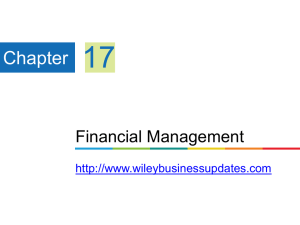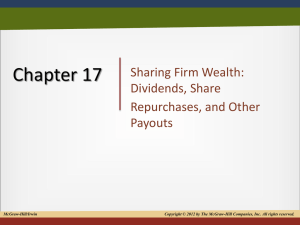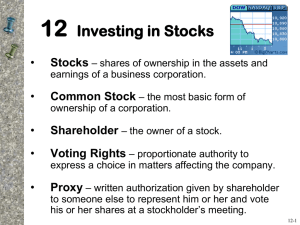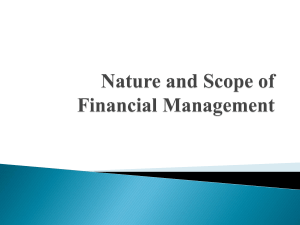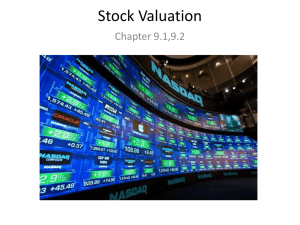Chapter 16
advertisement
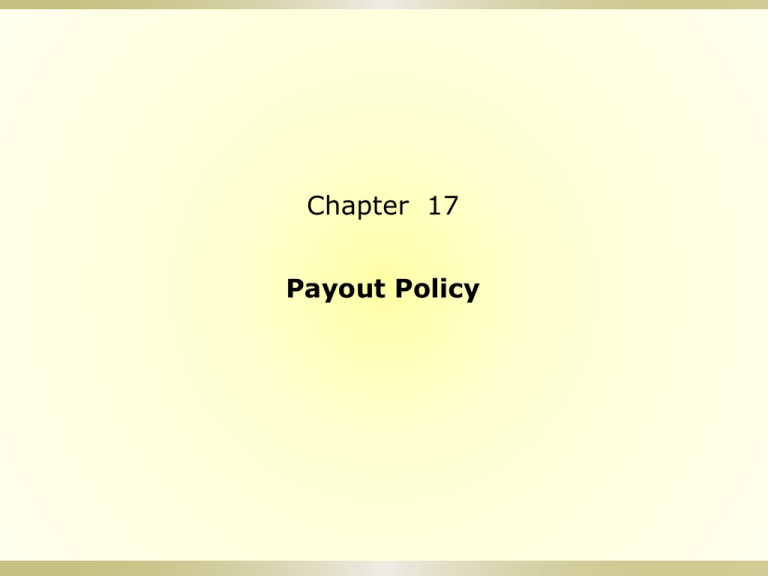
Chapter 17 Payout Policy Chapter Outline 17.1 Cash Distributions to Shareholders 17.2 Dividends Versus Share Repurchase in a Perfect Capital Market 17.3 The Tax Disadvantage of Dividends 17.4 Payout Versus Retention of Cash 17.5 Signaling with Payout Policy 17.6 Stock Dividends, Splits, and Spin-offs 17.7 Advice for the Financial Manager Learning Objectives Identify the different ways in which corporations can make distributions to shareholders Understand why the way in which they distribute cash flow does not affect value absent market imperfections Demonstrate how taxes can create an advantage for share repurchases versus dividends Learning Objectives (cont’d) Explain how increased payouts can reduce agency problems but potentially reduce financial flexibility Understand the role of payout policy in signaling information to the market Describe alternate non-cash methods for payouts 17.1 Cash Distributions to Shareholders Payout Policy The way a firm chooses between the alternative ways to pay cash out to shareholders Figure 17.1 Uses of Free Cash Flow 17.1 Cash Distributions to Shareholders Dividends Declaration Date Ex-Dividend Date Record Date Payable Date FIGURE 17.2 Important Dates for Microsoft’s Special Dividend 17.1 Cash Distributions to Shareholders Dividends Special Dividend Accounting Implications Return of Capital Liquidating Dividend Figure 17.3 Dividend History for GM Stock, 1983-2008 17.1 Cash Distributions to Shareholders Share Repurchases Open Market Repurchase Tender Offer Dutch Auction Targeted Repurchase Greenmail 17.2 Dividends Versus Share Repurchases in a Perfect Capital Market Assume Genron has $20 million in excess cash and no debt. The firm expects to generate additional free cash flows of $48 million per year in subsequent years. If Genron’s unlevered cost of capital is 12%, then the enterprise value of its ongoing operations is: $48 million Enterprise Value PV (Future FCF) $400 million 12% 17.2 Dividends Versus Share Repurchases in a Perfect Capital Market Genron’s board is meeting to decide how to pay out its $20 million in excess cash to shareholders The board is considering three options: 1. 2. 3. Use the $20 million to pay a $2 cash dividend for each of Genron’s 10 million outstanding shares Repurchase shares instead of paying a dividend Raise additional cash to pay an even larger dividend today and in the future 17.2 Dividends Versus Share Repurchases in a Perfect Capital Market Alternative Policy 1: Pay Dividend with Excess Cash With 10 million shares outstanding, Genron will be able to pay a $2 dividend immediately Because the firm expects to generate future free cash flows of $48 million per year, it anticipates paying a dividend of $4.80 per share each year thereafter 17.2 Dividends Versus Share Repurchases in a Perfect Capital Market Alternative Policy 1: Pay Dividend with Excess Cash Genron’s share price just before the stock pays its dividend (cum-dividend): 4.80 Pcum Current Dividend PV (Future Dividends) 2 2 40 $42 0.12 Genron’s share price just after the stock goes exdividend: 4.80 Pex PV (Future Dividends) 0.12 $40 17.2 Dividends Versus Share Repurchases in a Perfect Capital Market Alternative Policy 1: Pay Dividend with Excess Cash In a perfect capital market, when a dividend is paid, the share price drops by the amount of the dividend when the stock begins to trade exdividend 17.2 Dividends Versus Share Repurchases in a Perfect Capital Market Alternative Policy 2: Share Repurchase (No Dividend) Suppose that Genron does not pay a dividend this year, but instead uses the $20 million to repurchase its shares on the open market How will the repurchase affect the share price? 17.2 Dividends Versus Share Repurchases in a Perfect Capital Market Alternative Policy 2: Share Repurchase (No Dividend) With an initial share price of $42, Genron will repurchase $20 million ÷ $42 per share = 0.476 million shares, leaving only 10 – 0.476 = 9.524 million shares outstanding 17.2 Dividends Versus Share Repurchases in a Perfect Capital Market Alternative Policy 2: Share Repurchase (No Dividend) 17.2 Dividends Versus Share Repurchases in a Perfect Capital Market Alternative Policy 2: Share Repurchase (No Dividend) The market value of Genron’s assets falls when the company pays out cash, but the number of shares outstanding also falls from 10 million to 9.524 million The two changes offset each other, so the share price remains the same at $42 17.2 Dividends Versus Share Repurchases in a Perfect Capital Market Alternative Policy 2: Share Repurchase (No Dividend) Genron’s Future Dividends In future years, Genron expects to have $48 million in free cash flow, which can be used to pay a dividend of $48 million ÷ 9.524 million shares = $5.04 per share each year. Thus, Genron’s share price today is: Prep 5.04 $42 0.12 17.2 Dividends Versus Share Repurchases in a Perfect Capital Market Alternative Policy 2: Share Repurchase (No Dividend) Genron’s Future Dividends In perfect capital markets, an open market share repurchase has no effect on the stock price, and the stock price is the same as the cum-dividend price if a dividend were paid instead 17.2 Dividends Versus Share Repurchases in a Perfect Capital Market Alternative Policy 2: Share Repurchase (No Dividend) Investor Preferences Would an investor prefer that Genron issue a dividend or repurchase its stock? Assume an investor holds 2000 shares of Genron Stock The investor’s holdings after a dividend or share repurchase are: 17.2 Dividends Versus Share Repurchases in a Perfect Capital Market Alternative Policy 2: Share Repurchase (No Dividend) Investor Preferences Would an investor prefer that Genron issue a dividend or repurchase its stock? In either case, the value of the investor’s portfolio is $84,000 17.2 Dividends Versus Share Repurchases in a Perfect Capital Market Alternative Policy 2: Share Repurchase (No Dividend) Investor Preferences What if the firm repurchases shares but investor wants cash? The investor could sell shares to raise cash (aka homemade dividend) 17.2 Dividends Versus Share Repurchases in a Perfect Capital Market Alternative Policy 2: Share Repurchase (No Dividend) Investor Preferences What if the firm pays a dividend and the investor does not want cash? The investor could use the dividend to purchase additional shares 17.2 Dividends Versus Share Repurchases in a Perfect Capital Market Alternative Policy 2: Share Repurchase (No Dividend) Investor Preferences In either case, the value of the investor’s portfolio is $84,000 In perfect capital markets, investors are indifferent between the firm distributing funds via dividends or share repurchases By reinvesting dividends or selling shares, they can replicate 17.2 Dividends Versus Share Repurchases in a Perfect Capital Market Alternative Policy 3: High Dividend (Equity Issue) Assume Genron plans to pay $48 million in dividends starting next year Suppose the firm wants to start paying that amount today Because it has only $20 million in cash today, Genron needs an additional $28 million to pay the larger dividend now 17.2 Dividends Versus Share Repurchases in a Perfect Capital Market Alternative Policy 3: High Dividend (Equity Issue) One was way to raise more cash is to borrow money or sell new shares Given a current share price of $42, Genron could raise $28 million by selling $28 million $42 per share = 0.67 million shares 17.2 Dividends Versus Share Repurchases in a Perfect Capital Market Alternative Policy 3: High Dividend (Equity Issue) Because this equity issue will increase Genron’s total number of shares outstanding to 10.67 million, the amount of the dividend per share each year will be: $48 million $4.50 per share 10.67 million shares 17.2 Dividends Versus Share Repurchases in a Perfect Capital Market Alternative Policy 3: High Dividend (Equity Issue) Under this new policy, Genron’s cum-dividend share price is: 4.50 Pcum 4.50 4.50 37.50 $42 0.12 The initial share value is unchanged by this policy, and increasing the dividend has no benefit to shareholders Example 17.1 Homemade Dividends Problem: Suppose Genron does not adopt the third alternative policy, and instead pays a $2 dividend per share today. Show how an investor holding 2000 shares could create a homemade dividend of $4.50 per share 2000 shares = $9000 per year on her own. Example 17.1 Homemade Dividends Solution: Plan: If Genron pays a $2 dividend, the investor receives $4000 in cash and holds the rest in stock. She can raise $5000 in additional cash by selling 125 shares at $40 per share just after the dividend is paid. Example 17.1 Homemade Dividends Execute: The investor creates her $9000 this year by collecting the $4000 dividend and then selling 125 shares at $40 per share. In future years, Genron will pay a dividend of $4.80 per share. Because she will own 2000 – 125 = 1875 shares, the investor will receive dividends of 1875 $4.80 = $9000 per year from then on. Example 17.1 Homemade Dividends Evaluate: Again, the policy that the firm chooses is irrelevant—the investor can transact in the market to create a homemade dividend policy that suits her preferences. Example 17.1a Homemade Dividends Problem: Suppose Genron does not adopt the third alternative policy, and instead pays a $2 dividend per share today. Show how an investor holding 6,000 shares could create a homemade dividend of $4.50 per share 6,000 shares = $27,000 per year on her own. Example 17.1a Homemade Dividends Solution: Plan: If Genron pays a $2 dividend, the investor receives $12,000 in cash and holds the rest in stock. She can raise $15,000 in additional cash by selling 375 shares at $40 per share just after the dividend is paid. Example 17.1a Homemade Dividends Execute: The investor creates her $27,000 this year by collecting the $12,000 dividend and then selling 375 shares at $40 per share. In future years, Genron will pay a dividend of $4.80 per share. Because she will own 6,000 – 375 = 5,625 shares, the investor will receive dividends of 5,625 $4.80 = $27,000 per year from then on. Example 17.1a Homemade Dividends Evaluate: Again, the policy that the firm chooses is irrelevant—the investor can transact in the market to create a homemade dividend policy that suits her preferences. 17.2 Dividends Versus Share Repurchases in a Perfect Capital Market Modigliani-Miller and Dividend Policy Irrelevance In perfect capital markets, holding fixed the investment policy of a firm, the firm’s choice of dividend policy is irrelevant and does not affect the initial share price Table 17.1 Genron’s Dividends per Share Each Year Under the Three Alternative Policies 17.2 Dividends Versus Share Repurchases in a Perfect Capital Market Dividend Policy and Perfect Capital Markets Although dividends do determine share prices, a firm’s choice of dividend policy does not A firm’s free cash flows determine the level of payouts that it can make to its investors In a perfect capital market, whether these payouts are made through dividends or share repurchases does not matter 17.3 The Tax Disadvantage of Dividends Taxes on Dividends and Capital Gains Shareholders typically must pay: Taxes on the dividends they receive Capital gains taxes when they sell their shares 17.3 The Tax Disadvantage of Dividends Taxes on Dividends and Capital Gains When a firm pays a dividend, shareholders are taxed according to the dividend tax rate If dividends are taxed at a higher rate than capital gains shareholders will prefer share repurchases to dividends Because long-term investors can defer the capital gains tax until they sell, there is still a tax advantage for share repurchases over dividends Table 17.2 Long-Term Capital Gains Versus Dividend Tax Rates in the United States, 1971–2010 17.3 The Tax Disadvantage of Dividends Optimal Dividend Policy with Taxes The optimal dividend policy when the dividend tax rate exceeds the capital gain tax rate is to pay no dividends at all Figure 17.4 Dividend and Capital Gains Tax Rates Around the World 17.3 The Tax Disadvantage of Dividends Optimal Dividend Policy with Taxes Dividends in Practice Prior to 1980, most firms used dividends exclusively to distribute cash to shareholders By 2009 about 30% of firms relied exclusively on dividends At the same time, 30% of all firms (and more than half of firms making payouts to shareholders) used share repurchases exclusively or in combination with dividends 17.3 The Tax Disadvantage of Dividends Optimal Dividend Policy with Taxes Dividends in Practice Dividend Puzzle When firms continue to issue dividends despite their tax disadvantage Figure 17.5 The Rise of Repurchases Table 17.3 Summary of Dividends Versus Repurchases 17.3 The Tax Disadvantage of Dividends Tax Differences Across Investors Dividend Tax Rate Factors Income Level Investment Horizon Tax Jurisdiction Type of Investor or Investment Account 17.3 The Tax Disadvantage of Dividends Tax Differences Across Investors Dividend Tax Rate Factors Long-term investors are more heavily taxed on dividends, so they would prefer share repurchases to dividend payments. One-year investors, pension funds, and other nontaxed investors have no tax preference for share repurchases over dividends; they would prefer a payout policy that most closely matches their cash needs 17.3 The Tax Disadvantage of Dividends Tax Differences Across Investors Dividend Tax Rate Factors Corporations enjoy a tax advantage associated with dividends due to the 70% exclusion rule A corporation that chooses to invest its cash will prefer to hold stocks with high dividend yields Figure 17.6 The Changing Composition of Shareholder Payouts 17.3 The Tax Disadvantage of Dividends Tax Differences Across Investors Clientele Effects When the dividend policy of a firm reflects the tax preferences of its investor clientele Individuals in the highest tax brackets have a preference for stocks that pay no or low dividends Tax-free investors and corporations have a preference for stocks with high dividends The dividend policy of a firm is optimized for the tax preference of its investor clientele Table 17.4 Differing Dividend Policy Preferences Across Investor Groups 17.4 Payout Versus Retention of Cash Retaining Cash with Perfect Capital Markets Buying and selling securities is a zero-NPV transaction, so it should not affect firm value Shareholders can make any investment a firm makes on their own if the firm pays out the cash The retention versus payout decision is irrelevant Example 17.2 Payout Decisions in a Perfect Capital Market Problem: Barston Mining has $100,000 in excess cash. Barston is considering investing the cash in one-year Treasury bills paying 2% interest, and then using the cash to pay a dividend next year. Alternatively, the firm can pay a dividend immediately and shareholders can invest the cash on their own. In a perfect capital market, which option will shareholders prefer? Example 17.2 Payout Decisions in a Perfect Capital Market Solution: Plan: We need to compare what shareholders would receive from an immediate dividend ($100,000), to the present value of what they would receive in one year if Barston invested the cash. Example 17.2 Payout Decisions in a Perfect Capital Market Execute: If Barston retains the cash, at the end of one year the company will be able to pay a dividend of $100,000 (1.02) = $102,000. Note that this payoff is the same as if shareholders had invested the $100,000 in Treasury bills themselves. In other words, the present value of this future dividend is exactly $102,000 (1.02) = $100,000, which is the same as the $100,000 shareholders would receive from an immediate dividend. Thus shareholders are indifferent about whether the firm pays the dividend immediately or retains the cash. Example 17.2 Payout Decisions in a Perfect Capital Market Evaluate: Because Barston is not doing anything that the investors could not have done on their own, it does not create any value by retaining the cash and investing it for the shareholders versus simply paying it to them immediately. As we showed in Example 17.1, if Barston retains the cash, but investors prefer to have the income today, they can sell $100,000 worth of shares. Example 17.2a Payout Decisions in a Perfect Capital Market Problem: Hershey Co. has $100,000 in excess cash. Hershey is considering investing the cash in one-year Treasury bills paying 4% interest, and then using the cash to pay a dividend next year. Alternatively, the firm can pay a dividend immediately and shareholders can invest the cash on their own. In a perfect capital market, which option will shareholders prefer? Example 17.2a Payout Decisions in a Perfect Capital Market Solution: Plan: We need to compare what shareholders would receive from an immediate dividend ($100,000), to the present value of what they would receive in one year if Hershey invested the cash. Example 17.2a Payout Decisions in a Perfect Capital Market Execute: If Hershey retains the cash, at the end of one year the company will be able to pay a dividend of $100,000 (1.04) = $104,000. Note that this payoff is the same as if shareholders had invested the $100,000 in Treasury bills themselves. In other words, the present value of this future dividend is exactly $104,000 (1.04) = $100,000, which is the same as the $100,000 shareholders would receive from an immediate dividend. Thus shareholders are indifferent about whether the firm pays the dividend immediately or retains the cash. Example 17.2a Payout Decisions in a Perfect Capital Market Evaluate: Because Hershey is not doing anything that the investors could not have done on their own, it does not create any value by retaining the cash and investing it for the shareholders versus simply paying it to them immediately. As we showed in Example 17.1a, if Hershey retains the cash, but investors prefer to have the income today, they can sell $100,000 worth of shares. Example 17.2b Payout Decisions in a Perfect Capital Market Problem: GoodBuy Co. has $375,000 in excess cash. GoodBuy is considering investing the cash in one-year Treasury bills paying 3.25% interest, and then using the cash to pay a dividend next year. Alternatively, the firm can pay a dividend immediately and shareholders can invest the cash on their own. In a perfect capital market, which option will shareholders prefer? Example 17.2b Payout Decisions in a Perfect Capital Market Solution: Plan: We need to compare what shareholders would receive from an immediate dividend ($375,000), to the present value of what they would receive in one year if GoodBuy invested the cash. Example 17.2b Payout Decisions in a Perfect Capital Market Execute: If GoodBuy retains the cash, at the end of one year the company will be able to pay a dividend of $375,000 (1.0325) = $387,187.50. Note that this payoff is the same as if shareholders had invested the $375,000 in Treasury bills themselves. In other words, the present value of this future dividend is exactly $387,187.50 (1.0325) = $375,000, which is the same as the $375,000 shareholders would receive from an immediate dividend. Thus shareholders are indifferent about whether the firm pays the dividend immediately or retains the cash. Example 17.2b Payout Decisions in a Perfect Capital Market Evaluate: Because GoodBuy is not doing anything that the investors could not have done on their own, it does not create any value by retaining the cash and investing it for the shareholders versus simply paying it to them immediately. As we showed in Example 17.1, if GoodBuy retains the cash, but investors prefer to have the income today, they can sell $375,000 worth of shares. 17.4 Payout Versus Retention of Cash Retaining Cash with Perfect Capital Markets MM Payout Irrelevance In perfect capital markets, if a firm invests excess cash flows in financial securities, the firm’s choice of payout versus retention is irrelevant and does not affect the initial value of the firm 17.4 Payout Versus Retention of Cash Retaining Cash with Imperfect Capital Markets Taxes and Cash Retention Cash can be thought of as equivalent to negative leverage so the tax advantage of leverage implies a tax disadvantage to holding cash Example 17.3 Retaining Cash with Corporate Taxes Problem: Recall Barston Mining from Example 17.2. Suppose Barston must pay corporate taxes at a 35% rate on the interest it will earn from the oneyear Treasury bill paying 2% interest. Would pension fund investors (who do not pay taxes on their investment income) prefer that Barston use its excess cash to pay the $100,000 dividend immediately or retain the cash for one year? Example 17.3 Retaining Cash with Corporate Taxes Solution: Plan: As in the original example, the comparison is between what shareholders could generate on their own and what shareholders will receive if Barston retains and invests the funds for them. The key question then is: what is the difference between the after-tax return that Barston can earn and distribute to shareholders versus the pension fund’s tax-free return on investing the $100,000? Example 17.3 Retaining Cash with Corporate Taxes Execute: Because the pension fund investors do not pay taxes on investment income, the results from the prior example still hold: they would get $100,000, invest it, and earn 2% to receive a total of $102,000 in one year. If Barston retains the cash for one year, it will earn an aftertax return on the Treasury bills of 2% (1 – 0.35) = 1.3% Thus, at the end of the year, Barston will pay a dividend of $100,000 (1.013) = $101,300. Example 17.3 Retaining Cash with Corporate Taxes Evaluate: This amount is less than the $102,000 the investors would have earned if they had invested the $100,000 in Treasury bills themselves. Because Barston must pay corporate taxes on the interest it earns, there is a tax disadvantage to retaining cash. Pension fund investors will therefore prefer that Barston pays the dividend now. Example 17.3a Retaining Cash with Corporate Taxes Problem: Recall Hershey Co. from Example 17.2a. Suppose Hershey must pay corporate taxes at a 35% rate on the interest it will earn from the oneyear Treasury bill paying 4% interest. Would pension fund investors (who do not pay taxes on their investment income) prefer that Hershey use its excess cash to pay the $100,000 dividend immediately or retain the cash for one year? Example 17.3a Retaining Cash with Corporate Taxes Solution: Plan: As in the original example, the comparison is between what shareholders could generate on their own and what shareholders will receive if Hershey retains and invests the funds for them. The key question then is: what is the difference between the after-tax return that Hershey can earn and distribute to shareholders versus the pension fund’s tax-free return on investing the $100,000? Example 17.3a Retaining Cash with Corporate Taxes Execute: Because the pension fund investors do not pay taxes on investment income, the results from the prior example still hold: they would get $100,000, invest it, and earn 4% to receive a total of $104,000 in one year. If Hershey retains the cash for one year, it will earn an aftertax return on the Treasury bills of 4% (1 – 0.35) = 2.60% Thus, at the end of the year, Hershey will pay a dividend of $100,000 (1.026) = $102,600. Example 17.3a Retaining Cash with Corporate Taxes Evaluate: This amount is less than the $104,000 the investors would have earned if they had invested the $100,000 in Treasury bills themselves. Because Hershey must pay corporate taxes on the interest it earns, there is a tax disadvantage to retaining cash. Pension fund investors will therefore prefer that Hershey pays the dividend now. Example 17.3b Retaining Cash with Corporate Taxes Problem: Recall GoodBuy Co. from Example 17.2b. Suppose GoodBuy must pay corporate taxes at a 39% rate on the interest it will earn from the oneyear Treasury bill paying 3.25% interest. Would pension fund investors (who do not pay taxes on their investment income) prefer that GoodBuy use its excess cash to pay the $375,000 dividend immediately or retain the cash for one year? Example 17.3b Retaining Cash with Corporate Taxes Solution: Plan: As in the original example, the comparison is between what shareholders could generate on their own and what shareholders will receive if GoodBuy retains and invests the funds for them. The key question then is: what is the difference between the after-tax return that GoodBuy can earn and distribute to shareholders versus the pension fund’s tax-free return on investing the $375,000? Example 17.3b Retaining Cash with Corporate Taxes Execute: Because the pension fund investors do not pay taxes on investment income, the results from the prior example still hold: they would get $375,000, invest it, and earn 3.25% to receive a total of $387,187.50 in one year. If GoodBuy retains the cash for one year, it will earn an aftertax return on the Treasury bills of 3.25% (1 – 0.39) = 1.9825% Thus, at the end of the year, GoodBuy will pay a dividend of $375,000 (1.019825) = $382,434.38. Example 17.3b Retaining Cash with Corporate Taxes Evaluate: This amount is less than the $ 387,187.50 the investors would have earned if they had invested the $375,000 in Treasury bills themselves. Because GoodBuy must pay corporate taxes on the interest it earns, there is a tax disadvantage to retaining cash. Pension fund investors will therefore prefer that GoodBuy pays the dividend now. 17.4 Payout Versus Retention of Cash Retaining Cash with Imperfect Capital Markets Investor Tax Adjustments When a firm retains cash, it must pay corporate tax on the interest it earns In addition, the investor will owe capital gains tax on the increased value of the firm The net result is that the interest on retained cash is taxed twice Under most tax regimes there remains a substantial tax disadvantage for the firm to retaining excess cash even after adjusting for investor taxes 17.4 Payout Versus Retention of Cash Retaining Cash with Imperfect Capital Markets Issuance and Distress Costs Firms retain cash balances to cover potential future cash shortfalls, which allows a firm to avoid the transaction costs of selling new debt or equity issues Used to avoid financial distress during temporary periods of operating losses A firm must balance the tax costs of holding cash with the potential benefits of not having to raise external funds in the future 17.4 Payout Versus Retention of Cash Retaining Cash with Imperfect Capital Markets Agency Costs of Retaining Cash There is no benefit to shareholders when a firm holds cash above and beyond its future investment or liquidity needs There are likely to be agency costs associated with having too much cash in the firm Paying out excess cash through dividends or share repurchases can boost the stock price by reducing managers’ ability and temptation to waste resources Example 17.4 Cutting NegativeNPV Growth Problem: Rexton Oil is an all-equity firm with 100 million shares outstanding. Rexton has $150 million in cash and expects future free cash flows of $65 million per year. Management plans to use the cash to expand the firm’s operations, which will in turn increase future free cash flows to $72.8 million per year. If the cost of capital of Rexton’s investments is 10%, how would a decision to use the cash for a share repurchase rather than the expansion change the share price? Example 17.4 Cutting NegativeNPV Growth Solution: Plan: We can use the perpetuity formula to value Rexton under the two scenarios. The repurchase will take place at market prices, so the repurchase itself will have no effect on Rexton’s share price. The main question is whether spending $150 million now (instead of repurchasing) to increase cash flows by $7.8 million per year is a positive-NPV project. Example 17.4 Cutting NegativeNPV Growth Execute: Repurchase: If Rexton does not expand, the value of its future free cash flows will be $65 million 10% = $650 million. Adding the $150 million in cash it currently has, Rexton’s market value is $800 million, or $8.00 per share. Example 17.4 Cutting NegativeNPV Growth Execute (cont’d): Repurchase: If Rexton does not expand, the value of its future free cash flows will be $65 million 10% = $650 million. Adding the $150 million in cash it currently has, Rexton’s market value is $800 million, or $8.00 per share. If Rexton repurchases shares, there will be no change to the share price: It will repurchase $150 million $8.00 / share = 18.75 million shares, so it will have assets worth $650 million with 81.25 million shares outstanding, for a share price of $650 million 81.25 million shares = $8.00 / share. In this case, cutting investment and growth to fund a share repurchase increases the share price by $0.72 per share ($8.00 - $7.28). Example 17.4 Cutting NegativeNPV Growth Evaluate: The share price is higher with the repurchase because the alternative of expansion has a negative NPV: It costs $150 million, but increases future free cash flows by only $7.8 million, for an NPV of: –$150 million + $7.8 million / 10% = –$72 million, or –$0.72 per share. Thus, the repurchase, by avoiding the expansion, keeps the shares from suffering the $0.72 loss. Example 17.4a Cutting NegativeNPV Growth Problem: Aaron Corp. is an all-equity firm with 15 million shares outstanding. Aaron has $14 million in cash and expects future free cash flows of $5 million per year. Management plans to use the cash to expand the firm’s operations, which will in turn increase future free cash flows to $6 million per year. If the cost of capital of Aaron’s investments is 8%, how would a decision to use the cash for a share repurchase rather than the expansion change the share price? Example 17.4a Cutting NegativeNPV Growth Solution: Plan: We can use the perpetuity formula to value Aaron under the two scenarios. The repurchase will take place at market prices, so the repurchase itself will have no effect on Aaron’s share price. The main question is whether spending $14 million now (instead of repurchasing) to increase cash flows by $1 million per year is a positive-NPV project. Example 17.4a Cutting NegativeNPV Growth Execute: Invest: Using the perpetuity formula, if Aaron invests the $14 million to expand, its market value will be: $6 million 8% = $75 million, or $5.00 per share with 15 million shares outstanding. Repurchase: If Aaron does not expand, the value of its future free cash flows will be $5 million 8% = $62.5 million. Adding the $14 million in cash it currently has, Aaron’s market value is $76.5 million, or $5.10 per share. Example 17.4a Cutting NegativeNPV Growth Execute (cont’d): Repurchase: If Aaron does not expand, the value of its future free cash flows will be $5 million 8% = $62.5 million. Adding the $14 million in cash it currently has, Aaron’s market value is $76.5 million, or $5.10 per share. If Aaron repurchases shares, there will be no change to the share price: It will repurchase $14 million $5.10/ share = 2.75 million shares, so it will have assets worth $62.5 million with 12.25 million shares outstanding, for a share price of $62.5 million 12.25 million shares = $5.10 / share. In this case, cutting investment and growth to fund a share repurchase increases the share price by $0.10 per share ($5.10 - $5.00). Example 17.4a Cutting NegativeNPV Growth Evaluate: The share price is higher with the repurchase because the alternative of expansion has a negative NPV: It costs $14 million, but increases future free cash flows by only $1 million, for an NPV of –$14 million +($1 million ÷ 8%) = -$1.5 million, or –$0.10 per share. Thus, the repurchase, by avoiding the expansion, keeps the shares from suffering the $0.10 loss. Table 17.5 Selected Firms with Large Cash Balances 17.5 Signaling with Payout Policy Asymmetric Information When managers have better information than investors regarding the future prospects of the firm, their payout decisions may signal this information 17.5 Signaling with Payout Policy Dividend Smoothing The practice of maintaining relatively constant dividends Firms raise their dividends only when they perceive a long-term sustainable increase in the expected level of future earnings, and cut them only as a last resort Figure 17.7 GM’s Earnings and Dividends per Share, 1985–2008 17.5 Signaling with Payout Policy Dividend Signaling The idea that dividend changes reflect managers’ views about a firm’s future earnings prospects When a firm increases its dividend, it sends a positive signal to investors that management expects to be able to afford the higher dividend for the foreseeable future. When managers cut the dividend, it may signal that they have given up hope that earnings will rebound in the near term and so need to reduce the dividend to save cash 17.5 Signaling with Payout Policy Dividend Signaling Changes in dividends should be viewed in the context of the type of new information managers are likely to have An increase of a firm’s dividend may be signal of a lack of investment opportunities A firm might cut its dividend to exploit new positiveNPV investment opportunities The dividend decrease might lead to a positive, rather than negative, stock price reaction. 17.5 Signaling with Payout Policy Signaling and Share Repurchases Share repurchases are a credible signal that the shares are under-priced, because if they are over-priced a share repurchase is costly for current shareholders 17.5 Signaling with Payout Policy Signaling and Share Repurchases Differences Between Share Repurchases and Dividends Managers are much less committed to share repurchases than to dividend payments Unlike with dividends, firms do not smooth their repurchase activity from year to year The cost of a share repurchase depends on the market price of the stock 17.6 Stock Dividends, Splits, and Spin-offs Stock Dividends and Splits In a stock split or stock dividend, the company issues additional shares rather than cash to its shareholders. If a company declares a 10% stock dividend, each shareholder will receive one new share of stock for every 10 shares already owned. Stock Splits: Stock dividends of 50% or higher With a 50% stock dividend, each shareholder will receive one new share for every two shares owned Also called a 3:2 (“3-for-2”) stock split A 100% stock dividend is equivalent to a 2:1 stock split 17.6 Stock Dividends, Splits, and Spin-offs Stock Dividends and Splits The firm does not pay out any cash to shareholders There is an increase in the number of shares outstanding The total market value of the is unchanged The stock price will fall because the same total equity value is now divided over a larger number of shares Stock dividends are not taxed There is no real consequence to a stock dividend 17.6 Stock Dividends, Splits, and Spin-offs Stock Dividends and Splits Stock Splits and Share Price The typical motivation for a stock split is to keep the share price in a range thought to be attractive to small investors Making the stock more attractive to small investors can increase the demand for and the liquidity of the stock, which may in turn boost the stock price On average, announcements of stock splits are associated with a 2% increase in the stock price Most firms use splits to keep their share prices from exceeding $100 17.6 Stock Dividends, Splits, and Spin-offs Stock Dividends and Splits Spin-Offs When a firm sells a subsidiary by selling shares as a non-cash special dividend in the subsidiary alone Advantages of a Spin-Off It avoids the transaction costs associated with such a sale The special dividend is not taxed as a cash distribution 17.7 Advice for the Financial Manager Overall, as a financial manager, you should consider the following when making payout policy decisions: For a given payout amount, try to maximize the after-tax payout to the shareholders Repurchases and special dividends are useful for making large, infrequent distributions to shareholders 17.7 Advice for the Financial Manager Overall, as a financial manager, you should consider the following when making payout policy decisions: Starting and increasing a regular dividend is seen by shareholders as an implicit commitment to maintain this level of regular payout indefinitely Because regular dividends are seen as an implicit commitment, they send a stronger signal of financial strength to shareholders than do infrequent distributions such as repurchases 17.7 Advice for the Financial Manager Overall, as a financial manager, you should consider the following when making payout policy decisions: Be mindful of future investment plans Table 17.6 Navigating the Payout Decision Chapter Quiz 1. 2. 3. 4. 5. What is an open-market share repurchase? In a perfect capital market, how important is the firm’s decision to pay dividends versus repurchase shares? What is the dividend puzzle? What possible signals does a firm give when it cuts its dividend? What are some advantages of a spinoff as opposed to selling the division and distributing the cash?



